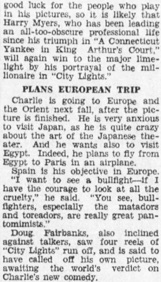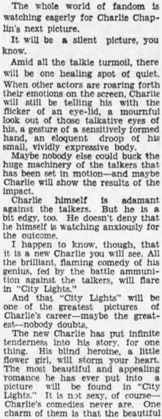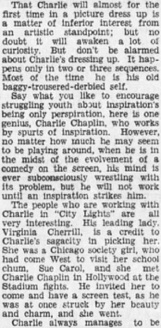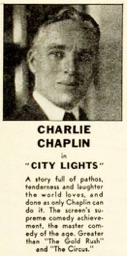City Lights 1930 1931 1932 next previous
City Lights Clippings 112/387
Los Angeles Times, Los Angeles, Cal., June 8, 1930.
CHARLIE CHAPLIN
in
„CITY LIGHTS“
A story full of pathos, tenderness and laughter, the world
loves, and done as only Chaplin can do it. The screen‘s
supreme comedy achievement, the master comedy of the age.
Greater than „The Gold Rush“ and „The Circus.“
(...) United Artists Ad, Film Daily, June 11, 1930.
Same text in Variety, June 11 & 18, 1930.
„He will not work until an inspiration strikes him“
Editorial content. „Chaplin GENIUS
SEEN IN SILENT
„City Lights“ Only Holdout
in World Gone Talkies
New Film Held Greatest in
Comedian‘s Career
Star Anxiously Awaiting
Reception by Fans
The whole world of fandom is watching eagerly for
Charlie Chaplin‘s next picture.
It will be a silent picture, you know.
Amid all the talkie turmoil, there will be one healing spot
of quiet. When other actors are roaring forth their
emotions on the screen, Charlie will still be telling his with
the flicker of an eye-lid, a mournful look out of those
talkative eyes of his, a gesture of a sensitively formed hand,
an eloquent droop of his small, vividly expressive body.
Maybe nobody else could buck the huge machinery of the
talkers that has been set in motion – and maybe Charlie
will show the results of the impact.
Charlie himself is adamant against the talkers. But
he is a bit edgy, too. He doesn‘t deny that he himself is watching anxiously for the outcome.
I happen to know, though, that it is a new Charlie
you will see. All the brilliant, flaming comedy of his genius,
fed by the battle ammunition against the talkers,
will flare in City Lights.
And that City Lights will be one of the greatest pictures of
Charlie‘s career – maybe the greatest – nobody doubts.
The new Chaplin has put infinite tenderness into his story,
for one thing. His blind heroine, a little flower girl, will
storm your heart. The most beautiful and appealing romance
he has ever put into a picture will be found in City Lights.
It is not sexy, of course – Charlie‘s comedies never are. One
charm of them is that the beautiful girl is always treated
with such gentle respect in his pictures.
Indeed, Charlie‘s treatment of femininity is one of the
secrets of his success. One of Charlie‘s axioms
in regard to comedies is, never allow a woman to be harshly
handled, especially a young and beautiful one.
If he wants to get some brutal comedy involving a woman
into a picture, he dresses up a man as a woman,
and lets the burlesque be apparent, but women are treated
gallantly, unless it be to win sympathy.
,Never,‘ said Charlie to me once, .let a pretty girl be
knocked about or do anything too strenuous in a
comedy. It takes away a subtle charm and a subtle chance
for contrast.‘
And the new Charlie takes on a wider field as a background
for his comedy. All the big features of a great city are
his props. And from all that seething life he is distilling a hugely
augmented variety of laughs, thrills, drama.
For drama there will be, too – a great deal of drama
involving the little tramp he is and the blind girl.
FOUR CHARACTERS
Yet, despite the scope of background, only four characters
are involved in the story – those mentioned, a millionaire
who is terribly dignified when sober but entirely clubby when
drunk, and a cop.
And against the drama and romance will appear some
of his most brilliant gags.
But this is not all. A new facet of Charlie‘s many-sided
genius appears, too, since he emerges as musical
composer! He is personally writing all the music and lyrics
for his picture!
Already he has completed three numbers, lyrics and music,
which are to be sung, and he is now at work on incidental
numbers. There is to be synchronized orchestration, since theater
orchestras are out in these days of talkers.
There is a likelihood that Charlie himself will sing one
of his own numbers! But I believe he hasn‘t fully decided about
this yet.
Nobody knows when or how Charlie learned music. He must
have merely absorbed it. In the music halls, where he played,
he listened. And there were remote moments with an old violin –
a good violin – that was given him once. Then there were
the talks with musicians, long conversations; and many hours
over piano and organ, when he harmonized, composed,
dreamed.
That Charlie will almost for the first time in a picture
dress up in a matter of inferior interest from an artistic standpoint;
but no doubt it will awaken a lot of curiosity. But don‘t
be alarmed about Charlie‘s dressing up. It happens only in two
or three sequences. Most of the time he is his old
baggy-trousered-derbied self.
Say what you like to encourage struggling youth about
inspiration‘s being only perspiration, here is one genius, Charlie
Chaplin, who works by spurts of inspiration. However,
no matter how much he may seem to be playing around, when
he is in the midst of the evolvement of a comedy on
the screen, his mind is ever subconsciously wrestling with
its problem, but he will not work until an inspiration
strikes him.
The people who are working with Charlie in City Lights are
all very interesting. His leading lady, Virginia Cherill,
is a credit to Charlie‘s sagacity in picking her. She was a Chicago
society girl, who had come West to visit her school
chum, Sue Carol, and she met Charlie Chaplin in Hollywood
at the Stadium fights. He invited her to come and have
a screen test, as he was at once struck by her beauty and charm,
and she went.
Charlie always manages to be good luck for the people
who play in his pictures, so it is likely that Harry Myers,
who has been leading an all-too-obscure professional life since
his triumph in A Connecticut Yankee in King Arthur‘s
Court, will again win to the major limelight by his portrayal
of the millionaire in City Lights.
PLANS EUROPEAN TRIP
Charlie is going to Europe and the Orient next fall, after
the picture is finished. He is very anxious to visit Japan,
as he is quite crazy about the art of the Japanese theater. And
he wants also to visit Egypt. Indeed, he plans to fly from
Egypt to Paris in an airplane.
Spain is his objective in Europe.
,I want to see a bullfight – if I have the courage to look at all
the cruelty,‘ he said. ,You see, bullfighters, especially
the matadors and toreadors, are really great pantomimists.‘
Doug Fairbanks, also inclined against talkers, saw
four reels of City Lights run off, and is said to have called off
his own picture, awaiting the world‘s verdict on Charlie‘s
new comedy.“
The contribution is not signed by name, but the author
must be Grace Kingsley.
Redaktioneller Inhalt
City Lights 1930 1931 1932 next previous










